The future of contact centers: omni-channel and customer experience
Platon Begun, Head of Contact Center CTI
Our brother IT specialist is always in the creative development process. CTI developers, for example, are currently working on a new product designed to optimize the work of contact centers. In this context, we want to tell in this material what new solutions are being created in the field of contact centers and what requirements they should meet, what are the trends. It is on the trends in a particular area that we can predict what solutions and developments will be in demand, what will appear on the market in the near future.

')
Contact centers that do not learn how to serve customers through various communication channels will leave the market in the coming years, analysts say. Along with traditional telephone and e-mail, clients are increasingly turning to services through chat rooms, social networks and instant messengers. They expect to be able to communicate with operators in just such a familiar way.

35% of clients contact CC via the Web; according to forecasts, this year self-service functions in KC will be used by 17% more clients; 35% increase in the number of customers using more than 4 channels; at the same time, when solving complex issues, 51% of clients prefer voice communications (according to Genesis, 2016).
This is especially characteristic of the “Generation Y”: young people aged 17 to 35 years more and more often choose digital channels as a means of communication - the fastest, most convenient and familiar ways of communication. They are used to always being in touch, constantly sending and receiving messages. In the same way, customers want to interact with companies: contact the operator and get an answer in the most convenient way for them.
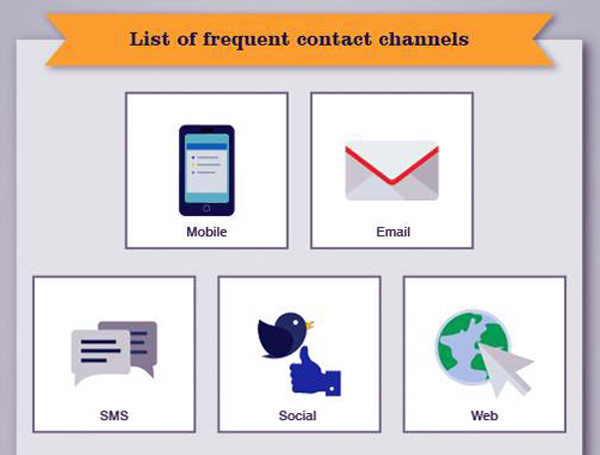
The most frequently used contact channels are mobile communication, e-mail, followed by SMS, social networks and the Web. Such data leads the website resolutions.cement.com .
Meanwhile, the business processes of contact centers are traditionally built for voice services, and now companies are forced to follow the trends and introduce new ways of communication with customers. New generation centers should provide all types of services through different communication channels, be able to keep the request context when changing the circulation channel (which allows the contact center employee to easily transfer communication with the customer from one channel to another), use the latest technologies to personalize customer interaction, possess intellectual functions for prioritizing requests, for example, for sending priority requests to the most experienced employees of the company.

The company ContactBabel recently surveyed more than 220 contact center managers and found out that 63% of them still consider the phone the best means of communication in case of complaints. Although the popularity of digital channels is growing, 57.7% of customer contacts still account for the phone.
According to Aberdeen, companies that have already gained some experience in omnichannel customer support, in 87% of cases, solve problems from the first call, while the average is only 59%. In 2017, contact centers will offer consumers an average of 9 support channels.

A modern CC is a complex, multi-component system that requires serious integration work, which constitutes its subsystems (according to Genesys).
In practice, alternative channels are often poorly integrated with the main “voice” platform of the contact center and perform only reference or information functions.
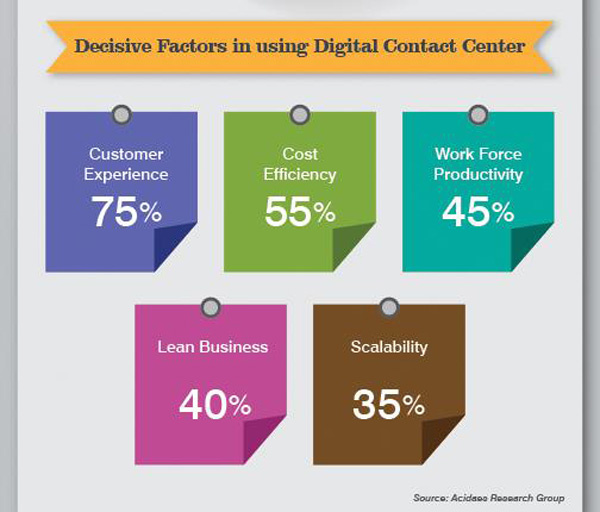
The main factors that determine the choice in favor of "digital" KC customers: customer experience, cost reduction, increase employee productivity, reduce business costs and scalability (according to crmsolutions.crmnext.com ).
Another important trend is the widespread use of automation and self-service. Automation of omnichannel service, actively implemented in KC in the last two years, will enable wider use of digital channels and unify the processes of omnichannel customer service.
Automated self-service systems provide many clients with the opportunity to resolve the issue themselves, while others can more quickly connect with the most qualified specialists. “Virtual agents” are able to respond not only to the most simple and easily understandable requests from a programmed sequence of answers, but they can use artificial intelligence algorithms for more complex communication.

The main factors that determine the use of clients by CC are: ease of working with it, quick access, time saving, constant readiness, intuitive interfaces, “ customer focus ” (according to crmsolutions.crmnext.com ).
At the same time, contact centers are more customer oriented, customer oriented. The former, traditional indicators and KPIs are no longer enough to realistically assess the work of CC, operators, to outline areas for improvement. You need to track and monitor indicators such as customer satisfaction, time to answer, the resolution of the question during the first call, the percentage of calls dropped and the cost of the call. According to the company Fonolo, 59% of business leaders surveyed consider customer satisfaction with service as the most important indicator of the work of the contact center.
The trend of “customer orientation” is also manifested in the development of contact center functionality, which allows reducing the number of missed calls, reducing the client's waiting time in a queue of calls, increasing the proportion of issues resolved in one call. Modern contact centers automatically provide operators with information about the customer who has called, keep a history of calls and provide other information for quick and prompt response.
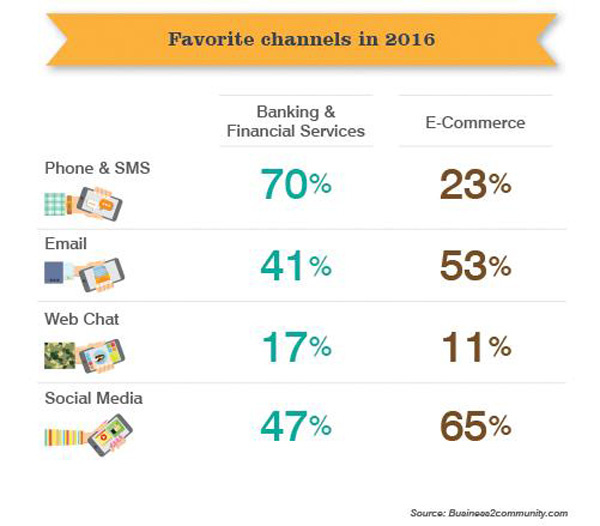
Customer-preferred channels of contacting the company for banks / financial institutions and e-commerce: telephone / SMS, email, Web-chat, social media. Such data leads the site crmsolutions.crmnext.com .
Traditional CUs are also beginning to experience strong competition from cloud services. More and more companies are turning to the cloud for solving customer service problems, preferring cloud services to software and hardware solutions placed on their site. Modern technologies are better, more flexible and easier to scale compared to traditional products. And in a difficult or unstable economic situation, cloud contact centers become a convenient and profitable solution that allows minimizing risks and transferring capital costs to operational ones.
As in the rest of the world, cloud contact centers in Russia are most actively used by retail, banks and other financial institutions. Cloud solutions are in demand, for example, in organizations engaged in consumer lending - due to the fact that they avoid the costs of creating your own CC.
Nearly 30% of participants in the Aberdeen study using contact centers in different countries plan to switch to the cloud model. According to statistics, the use of cloud contact centers can increase the Client Retention Rate by 57%, increase customer satisfaction by 12.6%, the success of the first interaction (First Contact Resolution) - by 4.6%, and the productivity of operators - by 4.3%. It is possible to significantly increase the efficiency of work with incoming requests while reducing the operating costs of CC.
Customer Experience (Customer Experience) is of the utmost importance, and this applies to a variety of industries. For example, market research suggests that in the banking / financial industry, obtaining a lower interest on loans or a higher interest on deposits for a client is not as important as the quality of service.
Customers demand from companies timely and high-quality solutions to their problems, with minimal effort on their part.

The company may never know why it lost a client. The reason is simple: the client is not satisfied with the quality of service, or he encounters any difficulties or obstacles in the process of communicating with the company. As a result, he just goes to competitors. According to statistics, on average, companies annually lose up to 10% of customers, and the cost of finding new ones is five times higher than the cost of keeping existing ones.
Today, customers interact with the business through multiple channels. They can use social networks, email, ask questions by phone or chat. To ensure customer satisfaction, each channel must work for a common positive experience.
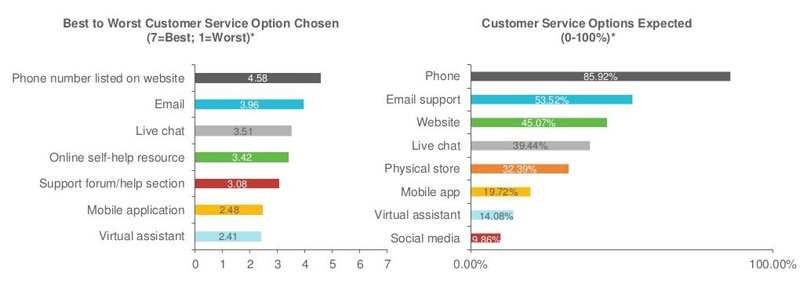
Preferred (left) and expected (right) customer communication channels. Current preferences: phone number on the company's website, email. mail, chat, online help, mobile app, virtual assistant. Expected: telephone, email support mail, website, chat, physical point of sale, mobile application, virtual assistant, social. media InContact / Harris Poll survey data.
Studying the experience of communicating with the client allows you to identify shortcomings in business processes and fix them in time. This requires analytical systems with advanced functionality.
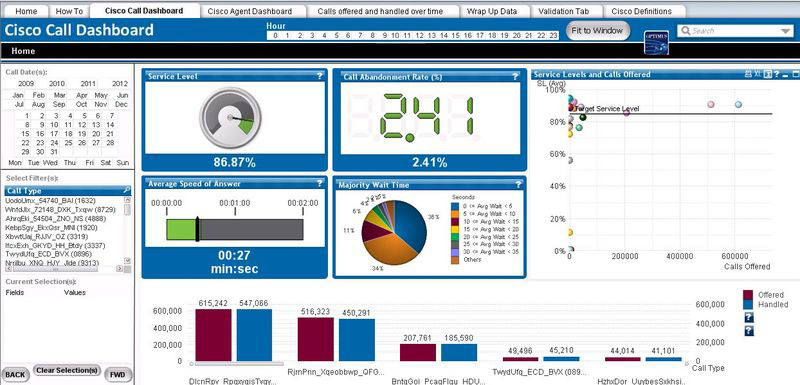
To understand that customer needs are met and their expectations are met, accurate information, a clear understanding of the situation and control of the process are necessary.
The contact center today is an important point of communication with customers. With well-built business processes of analyzing customer experience and monitoring customer satisfaction, you can get invaluable information to improve service processes.
According to Dimension Data, 82% of companies consider customer experience to be one of the main competitive differences, 75% of respondents believe that analytics can improve work efficiency, but 49.3% do not apply knowledge of customers outside the contact center. Only 34.2% of specialists use analytics to personalize services, and only 23% implement customer experience based on analytics.

“Life cycle” of customer experience (according to Informa, 2017).
According to analysts Gartner, in 2018 due to technology and individualized service, the total cost of business operations will be reduced by almost a third. Effective companies will conduct research and develop new technologies to reduce customer service costs. Those companies that can provide the fastest, most comfortable customer experience will win.
In this area, Russia is not far behind global trends. There are such methods of biometric identification of a client as a fingerprint, a scan of the retina and a drawing of the veins of the palm. Here are some pros (right) and minuses (left) of popular biometric identification technologies:
Voice recognition
+ Contactless technology, a small percentage of false recognitions
- External noises make identification difficult.
Fingerprint scan
+ Modern fingerprint scanners are quite reliable in recognition
- Scanners can be “fooled”
Iris Recognition
+ Extremely low probability of false recognition.
- Difficulties arise in the case of contact lenses, the iris changes with age. The scanner is an expensive and not very convenient device to use.
This mainly concerns banks: after delivery of their data, the client will be able to receive services remotely. In the future, the system may be used in other industries.
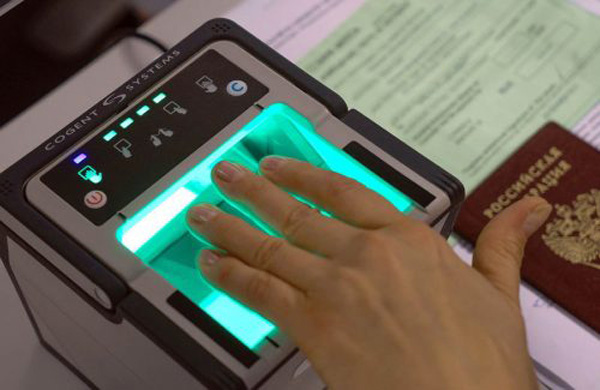
If a single biometric base appears for the Russians, then a legal base will be created that allows the use of biometric methods in customer identification processes for remote services, including in contact centers.
The Ministry of Communications and Mass Media has already approved the concept and the “road map” for the creation of a Unified Biometric System in Russia. According to media reports, in 2018, Russian banks will begin the full implementation of a single biometric customer identification system. After that, it can be used in medicine, education and retail. The date of the full launch of the system in 2018 will depend on the readiness of banks and the legislative framework.
So let's summarize. Technologies in KC follow global trends. Many companies are already implementing or planning to introduce omnichannel service, as well as technologies for analyzing large volumes of unstructured data collected from various sources (Big data). Big data analytics helps quantify customer experience and draw valuable insights to shape a company's communications strategy with clients.
There is a growing interest in technologies that allow organizing remote self-service processes. Companies have an interest in such solutions, but for now they are mainly exploring the possibilities of their use in customer service business processes, although there are already examples of successful implementations.
In focus - simplicity and convenience for users. What is convenient for the client, and will be in demand by the market.
When building KC in companies, we are faced with the need to introduce the omnichannel service demanded by the market. We offer ready-made solutions from Western vendors, but there is a certain shortage of universal technologies applicable on the platform of any CC. Therefore, now we are developing our own product that meets the functional requirements of our customers (including banks) and their requests - CTI Omni. This is a solution that will automate the business of omnichannel service, regardless of which voice platform is installed in the organization.
It provides a wide range of tasks related to receiving and processing requests, attracting new partners and customers, improving the quality of customer service, increasing their loyalty and satisfaction, and, consequently, increasing the company's profitability. Service users have the opportunity to focus on business, rather than on solving technical issues.
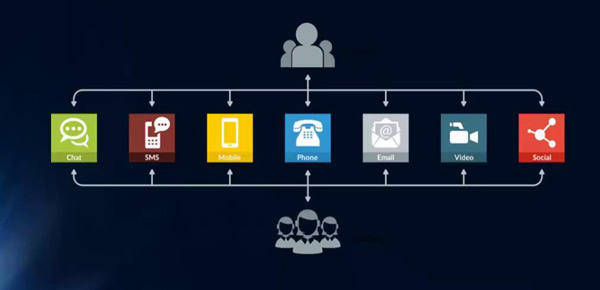
The main idea of CTI Omni is to give contact center users the opportunity to access all services, regardless of the channel of communication to CC, and for companies to predict the behavior of their customers.
Now there are practically no solutions on the market that have the same advanced functions for processing digital channels, like telephone communication in voice contact centers, and existing developments require from the owners of CC a complete change of voice platform. As a result, the organization of omnichannel service requires significant costs.
CTI experts themselves decided to create a technology that meets the modern requirements of customers and allows them to integrate the omni-channel concept into the existing CC. Such a solution creates additional opportunities for increasing sales, allows to increase the loyalty of customers and customers to the brand, to take into account individual customer preferences.
The benefits and advantages for customers are obvious - they can get better remote and remote service. This increases the convenience of access to the services of companies, saves time and provides quality service.
In the concept of omnichannel CC, knowledge management acquires great importance. When using knowledge bases, customer self-service mechanisms become more efficient, processing time for applications is reduced, and maintenance costs decrease. In addition, the knowledge base supports marketing and sales, as well as provides access to correct information not only to CC operators, but also to all employees of the organization.
As always, from a general point of view, the KC market is waiting for solutions that will improve the quality of customer service, the security of remote services and at the same time will be able to optimize the expenses of KC for customer service.
A few years ago, in order, for example, to get a loan, you had to spend time in the queue, and now you need a mobile application, phone service or just a chat.
If we talk about contact centers, then it can be argued that :
Thanks to the next-generation contact centers, built on the basis of the most modern technologies and the world's best practices, it is possible to qualitatively improve the level of customer service, reach a new level of controllability of KC resources.
The next stage of the evolution of contact centers will allow to rise to a new level of customer service.
Our brother IT specialist is always in the creative development process. CTI developers, for example, are currently working on a new product designed to optimize the work of contact centers. In this context, we want to tell in this material what new solutions are being created in the field of contact centers and what requirements they should meet, what are the trends. It is on the trends in a particular area that we can predict what solutions and developments will be in demand, what will appear on the market in the near future.

')
Key trends: omni channel, automation and cloud technology
Contact centers that do not learn how to serve customers through various communication channels will leave the market in the coming years, analysts say. Along with traditional telephone and e-mail, clients are increasingly turning to services through chat rooms, social networks and instant messengers. They expect to be able to communicate with operators in just such a familiar way.

35% of clients contact CC via the Web; according to forecasts, this year self-service functions in KC will be used by 17% more clients; 35% increase in the number of customers using more than 4 channels; at the same time, when solving complex issues, 51% of clients prefer voice communications (according to Genesis, 2016).
This is especially characteristic of the “Generation Y”: young people aged 17 to 35 years more and more often choose digital channels as a means of communication - the fastest, most convenient and familiar ways of communication. They are used to always being in touch, constantly sending and receiving messages. In the same way, customers want to interact with companies: contact the operator and get an answer in the most convenient way for them.

The most frequently used contact channels are mobile communication, e-mail, followed by SMS, social networks and the Web. Such data leads the website resolutions.cement.com .
Meanwhile, the business processes of contact centers are traditionally built for voice services, and now companies are forced to follow the trends and introduce new ways of communication with customers. New generation centers should provide all types of services through different communication channels, be able to keep the request context when changing the circulation channel (which allows the contact center employee to easily transfer communication with the customer from one channel to another), use the latest technologies to personalize customer interaction, possess intellectual functions for prioritizing requests, for example, for sending priority requests to the most experienced employees of the company.

The company ContactBabel recently surveyed more than 220 contact center managers and found out that 63% of them still consider the phone the best means of communication in case of complaints. Although the popularity of digital channels is growing, 57.7% of customer contacts still account for the phone.
According to Aberdeen, companies that have already gained some experience in omnichannel customer support, in 87% of cases, solve problems from the first call, while the average is only 59%. In 2017, contact centers will offer consumers an average of 9 support channels.

A modern CC is a complex, multi-component system that requires serious integration work, which constitutes its subsystems (according to Genesys).
In practice, alternative channels are often poorly integrated with the main “voice” platform of the contact center and perform only reference or information functions.

The main factors that determine the choice in favor of "digital" KC customers: customer experience, cost reduction, increase employee productivity, reduce business costs and scalability (according to crmsolutions.crmnext.com ).
Another important trend is the widespread use of automation and self-service. Automation of omnichannel service, actively implemented in KC in the last two years, will enable wider use of digital channels and unify the processes of omnichannel customer service.
Automated self-service systems provide many clients with the opportunity to resolve the issue themselves, while others can more quickly connect with the most qualified specialists. “Virtual agents” are able to respond not only to the most simple and easily understandable requests from a programmed sequence of answers, but they can use artificial intelligence algorithms for more complex communication.

The main factors that determine the use of clients by CC are: ease of working with it, quick access, time saving, constant readiness, intuitive interfaces, “ customer focus ” (according to crmsolutions.crmnext.com ).
At the same time, contact centers are more customer oriented, customer oriented. The former, traditional indicators and KPIs are no longer enough to realistically assess the work of CC, operators, to outline areas for improvement. You need to track and monitor indicators such as customer satisfaction, time to answer, the resolution of the question during the first call, the percentage of calls dropped and the cost of the call. According to the company Fonolo, 59% of business leaders surveyed consider customer satisfaction with service as the most important indicator of the work of the contact center.
The trend of “customer orientation” is also manifested in the development of contact center functionality, which allows reducing the number of missed calls, reducing the client's waiting time in a queue of calls, increasing the proportion of issues resolved in one call. Modern contact centers automatically provide operators with information about the customer who has called, keep a history of calls and provide other information for quick and prompt response.

Customer-preferred channels of contacting the company for banks / financial institutions and e-commerce: telephone / SMS, email, Web-chat, social media. Such data leads the site crmsolutions.crmnext.com .
Traditional CUs are also beginning to experience strong competition from cloud services. More and more companies are turning to the cloud for solving customer service problems, preferring cloud services to software and hardware solutions placed on their site. Modern technologies are better, more flexible and easier to scale compared to traditional products. And in a difficult or unstable economic situation, cloud contact centers become a convenient and profitable solution that allows minimizing risks and transferring capital costs to operational ones.
As in the rest of the world, cloud contact centers in Russia are most actively used by retail, banks and other financial institutions. Cloud solutions are in demand, for example, in organizations engaged in consumer lending - due to the fact that they avoid the costs of creating your own CC.
Nearly 30% of participants in the Aberdeen study using contact centers in different countries plan to switch to the cloud model. According to statistics, the use of cloud contact centers can increase the Client Retention Rate by 57%, increase customer satisfaction by 12.6%, the success of the first interaction (First Contact Resolution) - by 4.6%, and the productivity of operators - by 4.3%. It is possible to significantly increase the efficiency of work with incoming requests while reducing the operating costs of CC.
Learning customer experience in the process of communication with the company
Customer Experience (Customer Experience) is of the utmost importance, and this applies to a variety of industries. For example, market research suggests that in the banking / financial industry, obtaining a lower interest on loans or a higher interest on deposits for a client is not as important as the quality of service.
Customers demand from companies timely and high-quality solutions to their problems, with minimal effort on their part.

The company may never know why it lost a client. The reason is simple: the client is not satisfied with the quality of service, or he encounters any difficulties or obstacles in the process of communicating with the company. As a result, he just goes to competitors. According to statistics, on average, companies annually lose up to 10% of customers, and the cost of finding new ones is five times higher than the cost of keeping existing ones.
Today, customers interact with the business through multiple channels. They can use social networks, email, ask questions by phone or chat. To ensure customer satisfaction, each channel must work for a common positive experience.

Preferred (left) and expected (right) customer communication channels. Current preferences: phone number on the company's website, email. mail, chat, online help, mobile app, virtual assistant. Expected: telephone, email support mail, website, chat, physical point of sale, mobile application, virtual assistant, social. media InContact / Harris Poll survey data.
Studying the experience of communicating with the client allows you to identify shortcomings in business processes and fix them in time. This requires analytical systems with advanced functionality.

To understand that customer needs are met and their expectations are met, accurate information, a clear understanding of the situation and control of the process are necessary.
The contact center today is an important point of communication with customers. With well-built business processes of analyzing customer experience and monitoring customer satisfaction, you can get invaluable information to improve service processes.
According to Dimension Data, 82% of companies consider customer experience to be one of the main competitive differences, 75% of respondents believe that analytics can improve work efficiency, but 49.3% do not apply knowledge of customers outside the contact center. Only 34.2% of specialists use analytics to personalize services, and only 23% implement customer experience based on analytics.

“Life cycle” of customer experience (according to Informa, 2017).
According to analysts Gartner, in 2018 due to technology and individualized service, the total cost of business operations will be reduced by almost a third. Effective companies will conduct research and develop new technologies to reduce customer service costs. Those companies that can provide the fastest, most comfortable customer experience will win.
Introduction of a single biometric customer identification system
In this area, Russia is not far behind global trends. There are such methods of biometric identification of a client as a fingerprint, a scan of the retina and a drawing of the veins of the palm. Here are some pros (right) and minuses (left) of popular biometric identification technologies:
Voice recognition
+ Contactless technology, a small percentage of false recognitions
- External noises make identification difficult.
Fingerprint scan
+ Modern fingerprint scanners are quite reliable in recognition
- Scanners can be “fooled”
Iris Recognition
+ Extremely low probability of false recognition.
- Difficulties arise in the case of contact lenses, the iris changes with age. The scanner is an expensive and not very convenient device to use.
This mainly concerns banks: after delivery of their data, the client will be able to receive services remotely. In the future, the system may be used in other industries.

If a single biometric base appears for the Russians, then a legal base will be created that allows the use of biometric methods in customer identification processes for remote services, including in contact centers.
The Ministry of Communications and Mass Media has already approved the concept and the “road map” for the creation of a Unified Biometric System in Russia. According to media reports, in 2018, Russian banks will begin the full implementation of a single biometric customer identification system. After that, it can be used in medicine, education and retail. The date of the full launch of the system in 2018 will depend on the readiness of banks and the legislative framework.
Technologies in KC - what's new?
So let's summarize. Technologies in KC follow global trends. Many companies are already implementing or planning to introduce omnichannel service, as well as technologies for analyzing large volumes of unstructured data collected from various sources (Big data). Big data analytics helps quantify customer experience and draw valuable insights to shape a company's communications strategy with clients.
There is a growing interest in technologies that allow organizing remote self-service processes. Companies have an interest in such solutions, but for now they are mainly exploring the possibilities of their use in customer service business processes, although there are already examples of successful implementations.
In focus - simplicity and convenience for users. What is convenient for the client, and will be in demand by the market.
When building KC in companies, we are faced with the need to introduce the omnichannel service demanded by the market. We offer ready-made solutions from Western vendors, but there is a certain shortage of universal technologies applicable on the platform of any CC. Therefore, now we are developing our own product that meets the functional requirements of our customers (including banks) and their requests - CTI Omni. This is a solution that will automate the business of omnichannel service, regardless of which voice platform is installed in the organization.
It provides a wide range of tasks related to receiving and processing requests, attracting new partners and customers, improving the quality of customer service, increasing their loyalty and satisfaction, and, consequently, increasing the company's profitability. Service users have the opportunity to focus on business, rather than on solving technical issues.

The main idea of CTI Omni is to give contact center users the opportunity to access all services, regardless of the channel of communication to CC, and for companies to predict the behavior of their customers.
Now there are practically no solutions on the market that have the same advanced functions for processing digital channels, like telephone communication in voice contact centers, and existing developments require from the owners of CC a complete change of voice platform. As a result, the organization of omnichannel service requires significant costs.
CTI experts themselves decided to create a technology that meets the modern requirements of customers and allows them to integrate the omni-channel concept into the existing CC. Such a solution creates additional opportunities for increasing sales, allows to increase the loyalty of customers and customers to the brand, to take into account individual customer preferences.
The benefits and advantages for customers are obvious - they can get better remote and remote service. This increases the convenience of access to the services of companies, saves time and provides quality service.
In the concept of omnichannel CC, knowledge management acquires great importance. When using knowledge bases, customer self-service mechanisms become more efficient, processing time for applications is reduced, and maintenance costs decrease. In addition, the knowledge base supports marketing and sales, as well as provides access to correct information not only to CC operators, but also to all employees of the organization.
The future of KC - what the market is waiting for
As always, from a general point of view, the KC market is waiting for solutions that will improve the quality of customer service, the security of remote services and at the same time will be able to optimize the expenses of KC for customer service.
A few years ago, in order, for example, to get a loan, you had to spend time in the queue, and now you need a mobile application, phone service or just a chat.
If we talk about contact centers, then it can be argued that :
- Omni-channel service will allow to bring customer service processes to a higher level, meet customer expectations and increase their loyalty.
- The national biometric platform will stimulate the introduction of biometric identification of clients for remote maintenance, increase the security of access to services and speed up the process of remote identification of clients by operators of contact centers, help fight against financial fraud.
- Data analysis systems for measuring indicators that are crucial for customer service, such as customer path and customer experience, will enable organizations to obtain the necessary information to improve service processes and build a loyal customer base.
- Increasing the “intelligence” of self-service systems will allow contact centers to automate typical reference service procedures and improve their perception by customers.
Thanks to the next-generation contact centers, built on the basis of the most modern technologies and the world's best practices, it is possible to qualitatively improve the level of customer service, reach a new level of controllability of KC resources.
The next stage of the evolution of contact centers will allow to rise to a new level of customer service.
Source: https://habr.com/ru/post/335670/
All Articles